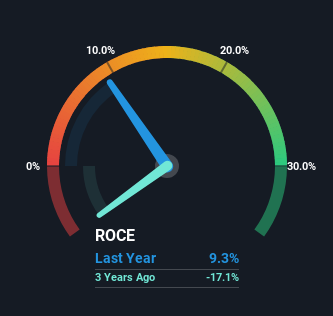- United States
- /
- Hospitality
- /
- NasdaqGS:SABR
Returns On Capital At Sabre (NASDAQ:SABR) Have Hit The Brakes
Finding a business that has the potential to grow substantially is not easy, but it is possible if we look at a few key financial metrics. In a perfect world, we'd like to see a company investing more capital into its business and ideally the returns earned from that capital are also increasing. Put simply, these types of businesses are compounding machines, meaning they are continually reinvesting their earnings at ever-higher rates of return. However, after briefly looking over the numbers, we don't think Sabre (NASDAQ:SABR) has the makings of a multi-bagger going forward, but let's have a look at why that may be.
Return On Capital Employed (ROCE): What Is It?
For those who don't know, ROCE is a measure of a company's yearly pre-tax profit (its return), relative to the capital employed in the business. The formula for this calculation on Sabre is:
Return on Capital Employed = Earnings Before Interest and Tax (EBIT) ÷ (Total Assets - Current Liabilities)
0.093 = US$332m ÷ (US$4.7b - US$1.1b) (Based on the trailing twelve months to June 2024).
So, Sabre has an ROCE of 9.3%. In absolute terms, that's a low return but it's around the Hospitality industry average of 10%.
Check out our latest analysis for Sabre

In the above chart we have measured Sabre's prior ROCE against its prior performance, but the future is arguably more important. If you'd like to see what analysts are forecasting going forward, you should check out our free analyst report for Sabre .
The Trend Of ROCE
Over the past five years, Sabre's ROCE has remained relatively flat while the business is using 23% less capital than before. This indicates to us that assets are being sold and thus the business is likely shrinking, which you'll remember isn't the typical ingredients for an up-and-coming multi-bagger. Not only that, but the low returns on this capital mentioned earlier would leave most investors unimpressed.
The Bottom Line On Sabre's ROCE
Overall, we're not ecstatic to see Sabre reducing the amount of capital it employs in the business. It seems that investors have little hope of these trends getting any better and that may have partly contributed to the stock collapsing 87% in the last five years. All in all, the inherent trends aren't typical of multi-baggers, so if that's what you're after, we think you might have more luck elsewhere.
One final note, you should learn about the 2 warning signs we've spotted with Sabre (including 1 which is a bit concerning) .
While Sabre may not currently earn the highest returns, we've compiled a list of companies that currently earn more than 25% return on equity. Check out this free list here.
New: Manage All Your Stock Portfolios in One Place
We've created the ultimate portfolio companion for stock investors, and it's free.
• Connect an unlimited number of Portfolios and see your total in one currency
• Be alerted to new Warning Signs or Risks via email or mobile
• Track the Fair Value of your stocks
Have feedback on this article? Concerned about the content? Get in touch with us directly. Alternatively, email editorial-team (at) simplywallst.com.
This article by Simply Wall St is general in nature. We provide commentary based on historical data and analyst forecasts only using an unbiased methodology and our articles are not intended to be financial advice. It does not constitute a recommendation to buy or sell any stock, and does not take account of your objectives, or your financial situation. We aim to bring you long-term focused analysis driven by fundamental data. Note that our analysis may not factor in the latest price-sensitive company announcements or qualitative material. Simply Wall St has no position in any stocks mentioned.
About NasdaqGS:SABR
Sabre
Operates as a software and technology company for travel industry in the United States, Europe, Asia-Pacific, and internationally.
Undervalued with moderate growth potential.
Similar Companies
Market Insights
Community Narratives



